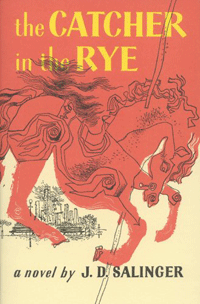Review of The Catcher in the Rye by JD Salinger

On the 27th January, JD Salinger died.
The 91-year-old only published one full-length novel… so how do we explain the enormous interest he arouses? Ironically, it was because he was recluse. Two years after the publication of his controversial novel The Catcher in the Rye he lived a life of seclusion, emerging only to fight legal battles when anyone attempted to release a movie or a book that was in any way related to him or his work.
The more he tried to shun any publicity, the more the public were intrigued, lapping up lurid details from ex-lovers, and his daughter Margaret.
In a strange way, his novel experienced the same fate. It was panned and banned for being vulgar, explicit, undermining family values and moral codes, as well as encouraging smoking and drinking and lying. Even in the last five years it features in the top-ten of books challenged when introduced as a school reading text in the US.
In 1981, 30 years after it was published it was both the most censored book, and the second-most taught book in American public schools. Every time there is a controversy the waiting lists at public libraries grow.
Even now, 60 years after it first appeared, 250,000 copies of the book are sold every year.
So what did Salinger create in this novel that has so attracted and repelled?
Firstly, the book was unique for its time in featuring a first-person stream of consciousness, using the "street talk" of the time rather than refined and edited sentences.
Secondly, it created the genre of young adult fiction. Until that point, adults had written novels for children which clearly set out the behaviour that was expected. Good people succeeded, evil was punished. In this novel, we have an unreliable narrator, a 16-year-old boy who is caught between being a child and becoming a man. It is a novel about rebellion and search for identity and an attempt to find connections. These are all themes recognisable in novels written for young adults today.
Thirdly, Salinger has presented the literary world with one of its most memorable anti-heroes, the protagonist Holden Caulfield. Sometimes his name is the first thing people remember about the book, a book most of us studied in school; but we also remember his angst and confusion.
Fourthly, it was the forerunner of the postmodern novel. Many of the events of the book are open to speculation because Holden is confused and sleep-deprived, and somewhat alcohol-affected! There is especially debate about the ending of the book. Some critics believe that Holden is destined to wander as the catcher, in the rye field on the edge of the cliff; others see it as an optimistic book, that Holden has succeeded in rescuing (catching) children from going down the path he chose.
Finally, the novel had much to say in the post-war euphoria. Salinger had experienced the atrocities of war, present at D-Day, and the Battle of the Bulge. He was among the first troops to enter Paris, and in the following year helped to liberate those remaining at Dachau Concentration Camp. He was hospitalised for stress following those experiences and told his daughter, "You never get the smell of burning flesh out of your nostrils entirely, no matter how long you live."
Salinger had seen the worst of humanity, and through Holden points to the shadows beneath the surface of the victors also. He is particularly critical of anything "phoney", anything inauthentic or ingenuous. That includes the superficiality of Hollywood, and girl-boy courting, and schools that try to impress parents rather than actually educate…
Another example of a phoney is a Christian businessman who gave a talk at Holden's school and told them that he prayed that God would bless his business. However, he was a funeral director…
For all the positives, it is also a troubling book. Holden is not a great role model. Neither was Salinger. He was a man who experimented with spiritualities and very young partners, and left a trail of apparently quite bitter people.
However, as one commentator has said, the enduring success of this novel shows that popularity does not necessarily require authors to be available via twitter or facebook or magazines; but if the book has some truth, then the author can even vanish, and the characters live on.















